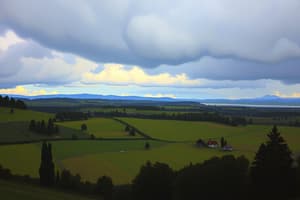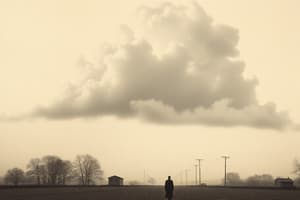Podcast
Questions and Answers
Which weather conditions should be expected beneath a low-level temperature inversion layer when the relative humidity is high?
Which weather conditions should be expected beneath a low-level temperature inversion layer when the relative humidity is high?
Smooth air, poor visibility, fog, haze, or low clouds.
What is meant by the term 'dewpoint'?
What is meant by the term 'dewpoint'?
The temperature to which air must be cooled to become saturated.
The amount of water vapor which air can hold depends on the?
The amount of water vapor which air can hold depends on the?
Air temperature.
What is a characteristic of stable air?
What is a characteristic of stable air?
Moist, stable air flowing upslope can be expected to?
Moist, stable air flowing upslope can be expected to?
At approximately what altitude above the surface would the pilot expect the base of cumuliform clouds if the surface air temperature is 82 degrees F and the dewpoint is 38 degrees F?
At approximately what altitude above the surface would the pilot expect the base of cumuliform clouds if the surface air temperature is 82 degrees F and the dewpoint is 38 degrees F?
A stable air mass is most likely to have which characteristic?
A stable air mass is most likely to have which characteristic?
Crests of standing mountain waves may be marked by stationary, lens-shaped clouds known as?
Crests of standing mountain waves may be marked by stationary, lens-shaped clouds known as?
The boundary between two different air masses is referred to as a?
The boundary between two different air masses is referred to as a?
Possible mountain wave turbulence could be anticipated when winds of 40 knots or greater blow?
Possible mountain wave turbulence could be anticipated when winds of 40 knots or greater blow?
Thunderstorms which generally produce the most intense hazard to aircraft are?
Thunderstorms which generally produce the most intense hazard to aircraft are?
In which situation is advection fog most likely to form?
In which situation is advection fog most likely to form?
In what layer of the atmosphere does most weather take place?
In what layer of the atmosphere does most weather take place?
How is hypoxia mitigated?
How is hypoxia mitigated?
What creates convective currents?
What creates convective currents?
Every physical process of weather is accompanied by, or is the result of, a?
Every physical process of weather is accompanied by, or is the result of, a?
The wind at 5,000 feet AGL is southwesterly while the surface wind is southerly.This difference in direction is primarily due to?
The wind at 5,000 feet AGL is southwesterly while the surface wind is southerly.This difference in direction is primarily due to?
What would decrease the stability of an air mass?
What would decrease the stability of an air mass?
What are characteristics of unstable air?
What are characteristics of unstable air?
The conditions necessary for the formation of cumulonimbus clouds are a lifting action and?
The conditions necessary for the formation of cumulonimbus clouds are a lifting action and?
What conditions are necessary for the formation of thunderstorms?
What conditions are necessary for the formation of thunderstorms?
What situation is most conducive to the formation of radiation fog?
What situation is most conducive to the formation of radiation fog?
If the temperature/dewpoint spread is small and decreasing, and the temperature is 62 F, what type of weather is most likely to develop?
If the temperature/dewpoint spread is small and decreasing, and the temperature is 62 F, what type of weather is most likely to develop?
What is the standard temperature lapse rate?
What is the standard temperature lapse rate?
What is the weight of the shortened column of air at 18,000 feet?
What is the weight of the shortened column of air at 18,000 feet?
What are the prevailing characteristics of low pressure systems?
What are the prevailing characteristics of low pressure systems?
Flashcards are hidden until you start studying
Study Notes
Weather Conditions and Air Properties
- High relative humidity beneath a low-level temperature inversion leads to smooth air, poor visibility, fog, haze, or low clouds due to stable atmospheric conditions.
- Dewpoint is defined as the temperature at which air must be cooled to become saturated, impacting humidity levels.
- The air temperature determines the maximum amount of water vapor air can hold, with warmer air capable of holding more moisture compared to cooler air.
- Characteristics of stable air include stratiform clouds, smooth air, continuous precipitation, and poor visibility, while unstable air features cumulus clouds and turbulence.
Cloud Formation and Types
- Moist, stable air moving upslope can create upslope fog, a specific type of low cloud.
- The base of cumuliform clouds forms at an altitude of approximately 10,000 feet AGL when surface temperature is 82°F and dewpoint is 38°F, with a lapse rate of 4.4°F per 1,000 feet.
- Standing lenticular clouds, lens-shaped clouds, form over crests of standing mountain waves caused by stable air interacting with topography.
Weather Fronts and Air Masses
- The boundary separating two distinct air masses is termed a front, essential for understanding weather patterns.
- Anticipation of mountain wave turbulence occurs when winds exceed 40 knots over a mountain ridge in stable air conditions.
Thunderstorms and Fog
- Squall line thunderstorms are the most hazardous to aircraft, producing severe storms with heavy hail and destructive winds.
- Advection fog forms when moist air moves inland from the coast over cooler surfaces, typically occurring in winter.
Atmospheric Layers and Hypoxia
- The troposphere is the layer where most weather occurs, extending from the surface to varying altitudes depending on location.
- Hypoxia can be mitigated by cabin pressurization and supplemental oxygen, crucial for maintaining safety at high altitudes.
Convective Currents and Stability
- Convective currents arise from surface variations that lead to uneven heating, creating localized air circulation, often resulting in turbulence during warmer weather.
- All weather processes involve heat exchange as water transitions between states, influencing weather patterns.
Wind and Air Mass Stability
- A discrepancy between surface winds and higher altitude winds is primarily due to friction with the Earth's surface, altering airflow patterns.
- Warming from below decreases stability in an air mass as cooler air remains lower while the warmer air ascends.
Characteristics of Air Stability
- Unstable air is marked by turbulence and good visibility, while stable air often contains dust or smoke, reducing visibility.
- Cumulonimbus clouds, associated with thunderstorms, form requiring unstable, moist air combined with lifting action.
Formation Conditions for Fog and Weather Metrics
- Radiation fog develops under warm, moist air conditions over low-lying areas during clear, calm nights.
- Low temperature/dewpoint spread leads to fog or low cloud formation when temperatures are above freezing.
- The standard temperature lapse rate describes a decrease of 2°C per 1,000 feet elevation gain, impacting temperature profiles.
- At 18,000 feet, the weight of air is 7.4 lb/sq in, representing nearly a 50% reduction compared to sea level.
- Low-pressure systems are associated with instability, cloudiness, and precipitation, indicating potential poor weather conditions.
Studying That Suits You
Use AI to generate personalized quizzes and flashcards to suit your learning preferences.




